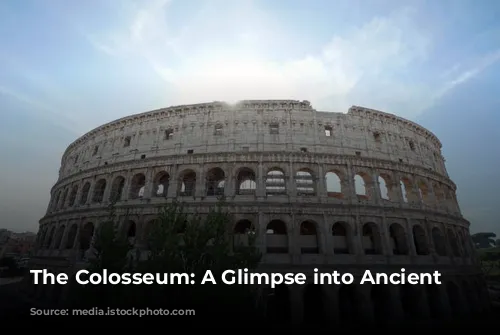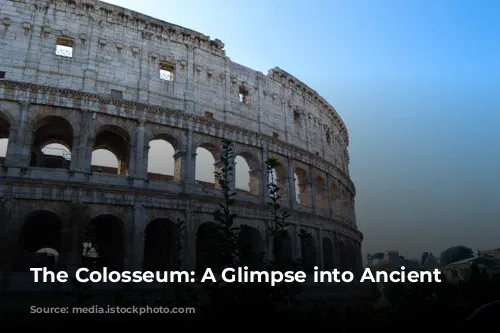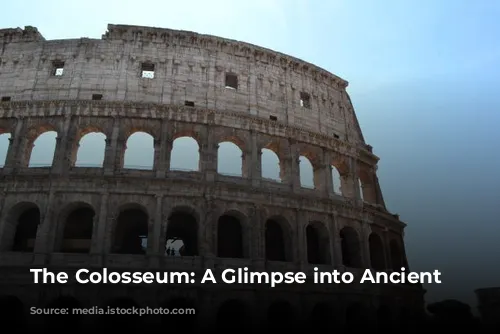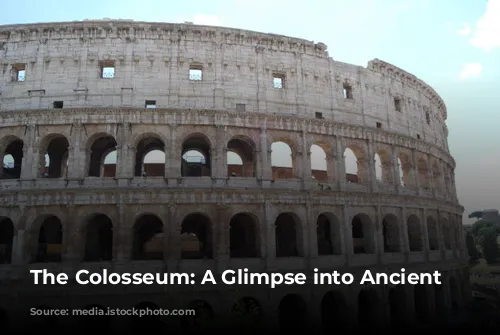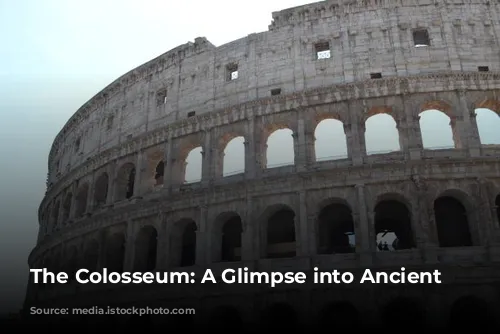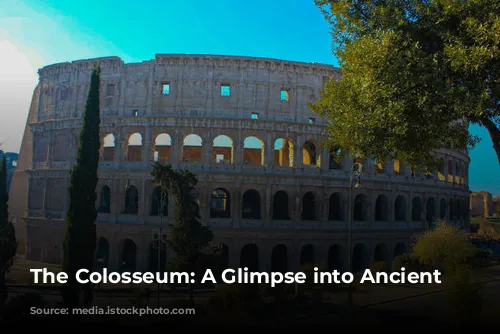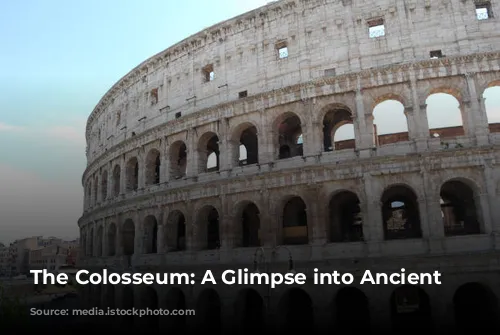The Colosseum, also known as the Flavian Amphitheatre, is a monumental symbol of the Roman Empire. It stands as a testament to the grandiose architectural achievements of the ancient world.
The Flavian Amphitheatre, named after the Flavian dynasty, was constructed by Emperor Vespasian. His son, Emperor Titus, inaugurated the arena in 80 AD.
The Colosseum’s inaugural spectacle was a lavish affair that lasted an astonishing one hundred days. The arena was filled with thousands of animals, spectacular fights, and dramatic performances. The event even included naumachiae, simulated naval battles that brought the grandeur of the Roman Navy to life.
The Colosseum: A Name with History
The Colosseum’s name has a fascinating origin. The moniker first appeared in a prophecy by the Venerable Bede, a medieval monk. Bede’s words were prophetic and powerful: “Rome will exist as long as the Colosseum does; when the Colosseum falls so will Rome; when Rome falls so will the world.”
The name likely stemmed from the Colossus of Nero, a massive statue of the Emperor Nero that stood near the amphitheatre.
The Colosseum was a symbol of Roman power, and Bede’s prophecy captured the enduring spirit of the Roman Empire.
The Colosseum: A Monument of Engineering
The Roman Colosseum is a feat of engineering. This elliptical structure was designed to hold a vast audience, with four floors and 80 arches on the first three levels. Statues adorned the second and third floors, adding to the monument’s splendor.
The Romans were masters of the arch, a structural technique that allowed them to distribute the weight of massive structures evenly. The Colosseum’s construction demonstrates this architectural expertise.
The Colosseum’s construction was remarkably swift, taking less than a decade to complete. This incredible feat was achieved through the Romans’ proficient use of the arch and their meticulous planning.
The Colosseum: A Historical Legacy
The Colosseum we see today is merely a skeleton of its former glory. The outer walls have suffered significant damage over the centuries.
The Roman Colosseum was a source of building materials during the Middle Ages. Marble, lead, and iron were extracted from the arena to construct structures like Barberini Palace, Piazza Venezia, and St. Peter’s.
The holes visible on many columns are remnants of this process, a testament to the Colosseum’s repurposing.
The Colosseum: An Arena for the People
The Colosseum could accommodate up to seventy thousand spectators. The seating arrangement was carefully designed to ensure a clear view for everyone, reflecting the Romans’ focus on public order and communal experience.
Entrance to the Colosseum was free for all Roman citizens, but seating was assigned based on social status. The upper tiers were reserved for the common people, while the lower tiers were reserved for senators, vestals, priests, and the emperor.
The Colosseum also featured a remarkable roof system, the Velarium, which provided protection from the sun. The Velarium, a massive linen canopy, was manipulated by sailors from the Imperial fleet, a spectacle that was as impressive as the events taking place in the arena.
The Colosseum: A Stage for Gladiators and Spectacles
The arena was the center of the Colosseum, where spectacular events took place. The underground cellars housed elaborate machinery that allowed for dramatic entrances and visual effects.
Animals and gladiators were lifted from the underground levels through trapdoors, appearing before the audience with spectacular bursts of white dust. Sets were also raised using complex systems of hinges and lifts, creating dynamic and immersive backdrops for hunting events.
The Colosseum was a place where entertainment and spectacle were seamlessly interwoven with political symbolism. The public displays fostered a sense of unity between the citizens and their leader.
The Colosseum: A World of Entertainment
A variety of spectacles took place in the Colosseum. Venationes, fights between exotic animals and humans, were popular attractions. Silvae, simulated forests filled with animals, offered a more dramatic experience, emphasizing the artistic and creative aspects of the arena’s offerings.
The gladiatorial combat was the pinnacle of the Colosseum’s entertainment. Gladiators, trained warriors, entertained the crowds with brutal battles. Their skill and bravery captivated the audience, making them heroes of the day.
Gladiators were often prisoners of war or men from the lower social strata, seeking fame and fortune. They were paid handsomely and enjoyed great popularity, especially among women.
The battles were intense and bloody, with the outcome often decided by the emperor based on the audience’s reaction. A thumbs up meant mercy, while a thumbs down meant death.
The Colosseum was a place of violent spectacle and entertainment, reflecting the brutality and pageantry of the Roman Empire.
The Colosseum: A Legacy of Beauty and History
The Colosseum has witnessed centuries of change. From an arena for gladiatorial combat to a quarry for building materials, it has endured the passage of time.
The Colosseum was threatened with demolition in the 16th century, but Pope Benedict XIV declared it a sacred monument dedicated to the Passion of Christ.
Today, the Colosseum is a monumental symbol of the Roman Empire, drawing millions of tourists each year. Standing in the Colosseum, one can feel the echoes of ancient history, imagining the roars of the crowd and the clash of gladiators.
The Colosseum is more than just a ruin. It is a powerful reminder of the grandeur, the brutality, and the enduring legacy of the Roman Empire.
